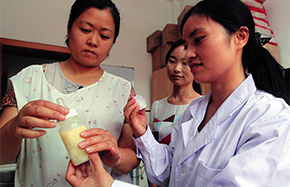Abbott develops new glucose sensor
Chinese patients with diabetes will no longer need to have their fingers pricked during the blood withdrawal process, thanks to a new glucose sensing technology by global healthcare company Abbott.
The US company has announced that its new FreeStyle Libre system allows glucose readings to be accurately obtained painlessly in real time. The system consists of a small round sensor slightly larger than a 1-yuan coin and can be worn on the back of the upper arm for up to 14 days.
Glucose levels in the patient is measured every minute in interstitial fluid through a small filament inserted just under the skin and held in place with a small adhesive pad. The patient can scan the sensor with a handheld reader and the result will be displayed in less than one second. The reader can store data for up to 90 days.
Each scan displays real-time glucose levels, the historical trend and the direction where the glucose is heading. Patients can also learn more about how food, exercise and insulin impact their glucose levels by downloading the data from the system.
Abbott's FreeStyle Libre system was approved by the China Food and Drug Administration in August. The company said that the system will soon be available in cities across China, with distribution channels extending to e-commerce platforms.
Dr Roger S Mazze, chief academic officer of International Diabetes Center, applauded the innovation, saying that it can help people achieve better glycemic control as well as provide patients and physicians with a complete picture of glucose variations.
According to Ji Linong, director of the department of endocrinology and metabolism at People's Hospital under Peking University, glucose monitoring is vital in helping people take control of their diabetes and reducing the risk of serious complications such as heart disease, kidney failure and diabetic foot.
A survey jointly conducted by Abbott and Chinese Medical Doctor Association earlier this year found out that at least 74 percent of diabetes patients in China do not monitor their glucose levels despite being advised by their doctors to do so. Inadequate emphasis, inconvenient monitoring and pain resulted from finger pricks were cited as the main reasons for irregular self-monitoring.
According to the World Health Organization, there were 110 million diabetes patients in China in 2015, about a tenth of the country's adult population. The number is expected to hit 150 million by 2040 if no further actions are taken immediately.
The International Diabetes Federation estimated that about 13 percent of the total medical expenditure in China is spent on diabetes treatment. In 2015, diabetes treatment expenditure in the country amounted to $51 billion, second only to the United States.



















